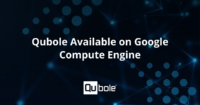Big Data 101: What Big Data Means For Social
It seems that every couple of months, the tech world is hit by another revolutionary product that will change our lives and make everything shiny and wonderful. But along with the hype comes a steady stream of jargon so technical that it can eliminate any interested party who doesn’t have a BS in Computer Science. So in order to rebel against industry buzzwords, I created a crash course on the newest trend – Big Data – without the use of technical mumbo-jumbo. I’ll explain what it is and how it applies to social media – the other largest phenomenon in tech.
What is Big Data?
It’s important to understand that Big Data isn’t new. It’s just… bigger. Data collection has been happening for years, but the difference is the amount of data we can collect on a subject. Simple, right? In the past, data collection was limited to the person collecting it, and what they wanted to track. Today we have big, strong super-computers that can’t get distracted by cellphone games or Thanksgiving dinner, so they can track exactly what you want while doing a bazillion other things.
If you look deeper into the subject, you’ll find that Big Data is defined by the 3 V’s: Volume, Velocity, and Variety. Volume is the amount of data being stored, and in the case of Big Data, this means a lot. Velocity is the rate at which data is being added, which is ridiculously high with the power of supercomputers. So rather than collecting data from one snapshot in time, you can collect and add to the data set continuously. Think of it as a river of data that is constantly flowing rather than a stagnant pool. As a result, the data is constantly being stored and added to the collection at alarming speeds.
Variety refers to the vast, diverse data you can collect. Where an old-school survey may ask ‘What car do you own,’ Big Data allows you to dig deeper. Not only do you know what car someone owns, you know where the driver goes, how fast he or she travels, and his or her favorite radio station.
Big data is literally big, but the process of using that data also defines it. This new size and scale of data collection are creating a huge wave of excitement in the tech community.
Why Should I Care?
So why is everyone making such a big deal about this? Simply put, it’s a dream come true for marketers and data nerds. With a larger set of information to draw from, you get a stronger understanding of your audience. You can analyze broader trends based on what people are doing with higher accuracy because you know everyone is contributing. This allows businesses to create a more targeted, specific marketing campaign. Of course, to get all this information, you have to find where it is being produced: social media.
What does this mean for social?
Social media and Big Data go hand-in-hand. Why? Because Social is a HUGE producer of data about everything by everyone. Every like, comment, retweet, check-in, and follow say a little bit more about what you like, hate, and everything in between. Companies are catching wind of this and are following the populous to find the best ways to capture consumer attention.
With this constant stream of social data, companies are discovering new, creative ways to showcase and analyze it. The only limit is how they connect all the data together.
How is Big Data being used with social?
Digital storytelling is a novel way to use Big Data. It provides a visual narrative to a storyline that would normally be one-dimensional. SGI, a digital graphic and computer solutions company, combined geo-targeting with a Twitter hashtag to create a video that showed the evolution in online conversation around Hurricane Sandy as it traveled through the United States.
‘Machine Learning’ is another huge buzzword in this realm. Remember those big, strong computers I mentioned? Well, they’re smart enough to understand what you do, analyze the information, and develop connections based on the data. A simple use case of this is finding the best posting times for your company. By learning when your social media posts get the strongest engagement, these super-computers can make smart suggestions as to when to post content.
One of the biggest uses of Big Data and social is through ‘likes’ and purchase patterns. Predictive analytics, (you know, the machine learning thing) allows companies to suggest complementary products to customers based on what others have bought. In fact, one Big Data experiment by Target accurately predicted a teen pregnancy before the rest of the family. Yes, it’s a bit creepy, invasive, and weird but also a testament to how detailed Big Data can be.
So that’s your crash course in Big Data, without all that confusing jargon. Now go out there and start collecting it yourself. You can get all of this through a number of different methods. If you’re a programmer (who for some reason doesn’t know about Big Data… weird), you can start collecting it through Hadoop. Or you can buy data from companies that house it. And if you’re a business or agency, you can use social media tools, like Viralheat, to collect the data.
Either way, don’t sleep on this new concept—it’s an invaluable asset to finding and understanding your audiences. Big Data is a big deal.
Author Bio: Jeff Anaya is part of the marketing team with Viralheat, the social media marketing suite for enterprise business. When he’s not talking, writing, or researching about the growing world of social media marketing, you can find him quoting movies from the 90s, podcasting at a pirate radio station in San Francisco’s Mission District, or planning a road trip. You can tweet him at @jeffanaya, add him to your Google+ circle, or email him at [email protected].




